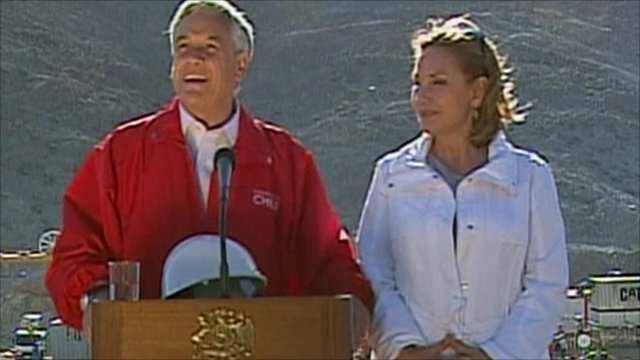
A rescuer has reached the bottom of the escape shaft, the first step in the rescue of 33 miners trapped deep underground for more than two months.
He went down in a rescue capsule to examine the condition of the shaft. Only once he has reported, will the men be brought up.
The first miner due to be winched to the surface should be Florencio Avalos.
Earlier, President Sebastian Pinera said he hoped what began as a possible tragedy, would end as a blessing.
“I know tonight there will be tears of happiness in all Chilean homes,” he told reporters. “We made a promise to never surrender, and we kept it.”
“I am sure the miners will not be the same people they were before the accident, and the Chilean people will not be the same people.”
The rescuer took 17 minutes to descend the 700m (2,295ft) to the refuge where the men have been for 68 days.
When he arrived, he was immediately questioned by the waiting miners about conditions during the descent.
Excitement
As night fell at the San Jose mine, near the northern city of Copiapo, Mining Minister Laurence Golborne said the rescue operation had been delayed by two hours, and would get under way after 2200 (0100 GMT).
He said an empty “Phoenix” capsule would first be sent down and up the 624m (2,047ft) shaft for further tests, before a technical expert was lowered very slowly to allow him to examine the state of the shaft in detail.
Continue reading the main story
After returning to the surface, he would report on his findings and then repeat the process at a faster speed, he added.
Only after a navy special forces paramedic has been lowered and has carried out an assessment of each of the miners, will the first be winched up.
“This whole process is going to take at least a couple of hours,” Mr Golborne said.
But he added: “We intend to finish today with the first of the miners on the surface.”
A technical co-ordinator, Rene Aguilar, said the delay was caused by the requirement to test three communication systems – one between the surface and the person in the rescue capsule, another between the surface and the refuge where the miners are located, and the third between doctors and the paramedic sent into the mine.
There were further delays after the capsule’s access door was damaged during the first test-run, technicians told the BBC. The problem occurred when it dropped below a section of the shaft lined in steel cladding.
Each ride up the shaft is expected to take about 20 minutes, and rescuers say they should be able to rescue one miner each hour. In all, the operation is likely to take 48 hours.
The first miner out is scheduled to be Florencio Avalos, the 31-year-old foreman and second-in-command at the mine. He will be temporarily leaving behind his younger brother, Renan, who is another of those trapped.
The last man is to be the shift leader, Luis Urzua, who has been credited with showing the leadership that enabled the miners to survive the first 17 days when they were entirely cut off from the outside world.
Correspondents say there is a sense of excitement on the surface, with the miners’ families counting down to the rescue attempt beginning.
President Pinera has spoken to the miners over a communication line but hopes to greet them in person, says the BBC’s Vanessa Buschschluter at the scene.
Bolivian President Evo Morales is also expected to arrive at San Jose to greet Carlos Mamani, a Bolivian national and the only non-Chilean in the group. He is scheduled to be the third miner brought to the surface.
Medical attention
The miners will wear a “bio-harness” designed for astronauts, which will monitor their heart rate, breathing, temperature and oxygen consumption.
The top of the shaft has been reinforced with metal casing to prevent crumbling surface rocks from breaking away during the rescue. Experts said the rest of the escape shaft was dug through solid rock and would not break up.
For the miners’ families who have mounted a vigil, the final hours are upon them Officials said the first few men to be winched to the surface would include some of the most psychologically stable and experienced of the miners, in case something goes wrong during the first few rescues.
Next would be those who are weakest or ill, the added. One miner suffers from hypertension. Another is a diabetic, and others have dental and respiratory infections or skin lesions caused by the humidity in the mine.
After their rescue, the miners will be taken to a triage station. When they have been cleared by doctors there, they will be reunited with their families.
Later, they will be flown to the hospital in the nearby city of Copiapo, which is on standby to receive them. Outside the hospital, barriers have been set up to cope with the crowds of onlookers and journalists.


















